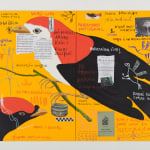Denilson Baniwa
Wirámiri (Passarinhos), 2024
acrílica, pastel oleoso e colagem sobre tela
[acrylic, oil pastels and collage on canvas]
[acrylic, oil pastels and collage on canvas]
130 x 200 x 3 cm díptico
130 x 100 x 3 cm cada
[51 1/8 x 78 3/4 x 1 1/8 in diptych
51 1/8 x 39 3/8 x 1 1/8 in each]
4.5 kg cada [each]
9 kg total [total]
130 x 100 x 3 cm cada
[51 1/8 x 78 3/4 x 1 1/8 in diptych
51 1/8 x 39 3/8 x 1 1/8 in each]
4.5 kg cada [each]
9 kg total [total]
Copyright The Artist
Further images
Nesta obra, Denilson Baniwa investiga dois universos de pensamento antagônicos, ambos focados na relação com a natureza. Por um lado, aborda criticamente a lógica colonial na composição, utilizando elementos do...
Nesta obra, Denilson Baniwa investiga dois universos de pensamento antagônicos, ambos focados na relação com a natureza. Por um lado, aborda criticamente a lógica colonial na composição, utilizando elementos do colecionismo e dos arquivos constituídos no Brasil do século XVI, retratando um cenário repleto de objetos como pássaros empalhados, revistas científicas e gravuras — uma representação da natureza estática, como explica o próprio artista. Em contrapartida, na visão dos Baniwa, os elementos naturais que foram saqueados são dotados de alma, vida, desejos e uma dimensão imaterial que vai além das limitações impostas pela lógica colonial.
[In this work, Denilson Baniwa investigates two antagonistic universes of thought, both focused on the relationship with nature. On the one hand, he critically approaches the colonial logic in the composition, using elements from the collection and archives established in 16th century Brazil, portraying a scene full of objects such as taxidermy birds, scientific journals and engravings - a representation of static nature, as the artist himself explains. In contrast, in the Baniwa's view, the natural elements that have been looted are blessed with soul, life, desires and an immaterial dimension that goes beyond the limitations imposed by colonial logic.]
[In this work, Denilson Baniwa investigates two antagonistic universes of thought, both focused on the relationship with nature. On the one hand, he critically approaches the colonial logic in the composition, using elements from the collection and archives established in 16th century Brazil, portraying a scene full of objects such as taxidermy birds, scientific journals and engravings - a representation of static nature, as the artist himself explains. In contrast, in the Baniwa's view, the natural elements that have been looted are blessed with soul, life, desires and an immaterial dimension that goes beyond the limitations imposed by colonial logic.]
1
of
21













